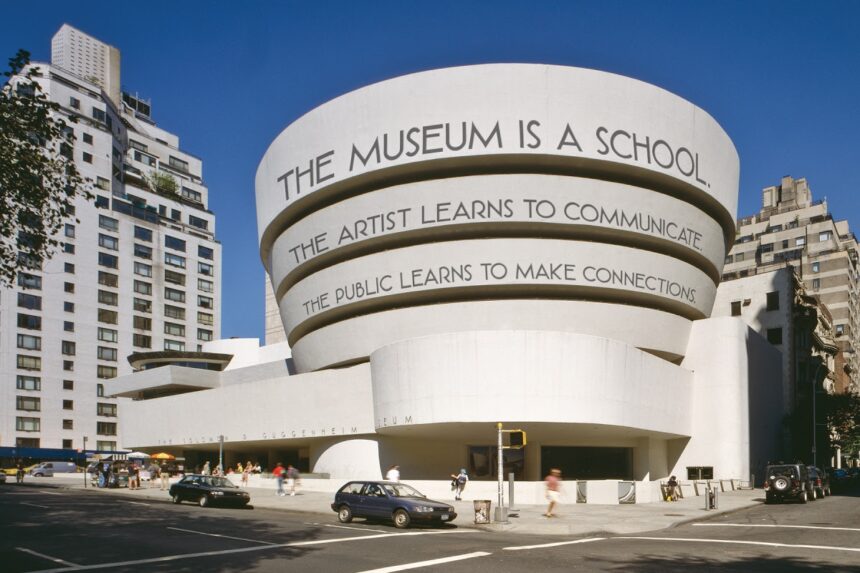Contents
Abu Dhabi is undergoing a major transformation as it invests billions into new construction projects to boost tourism, diversify its economy, and attract global talent. The Guggenheim museum, set to be 12 times larger than its New York counterpart, and other cultural landmarks like the Zayed National Museum are part of a $10 billion initiative to enhance the city’s cultural appeal. The massive translucent cones sliding down the sides of the Guggenheim museum in Abu Dhabi are finally visible to passersby whizzing through the city’s highway. It’s set to be about 12 times the size of its New York counterpart. Nearby, soaring metal structures resembling falcon wings sit atop the roof of the new Zayed National Museum, just miles from an upcoming natural history museum and a branch of the Louvre that opened in 2017. All around, there are growing signs of a massive construction boom that’s changing the face of this once sleepy, oil-rich emirate, which holds about 6% of the world’s crude reserves under its sands and controls $1.5 trillion in sovereign wealth.Sprawling theme parks, five-star hotels, luxury homes, sports complexes and high-end office towers are rising at breakneck speed as the city’s rulers spend billions to diversify the economy and cater to global financial giants like Brevan Howard Asset Management and Greg Coffey’s Kirkoswald Asset Management, who’ve set up here.The Guggenheim is part of a more than $10 billion push to boost tourism and cultural activity in the emirate, the capital of the United Arab Emirates. Meantime, Abu Dhabi is also pouring billions more into building sprawling residential developments to attract rich expatriates to live and work here. Wealthy buyers from the UK, India, Spain and beyond are snapping up seaside villas costing millions.There are challenges to the desert city’s big ambitions. The Middle East is heating up at one of the world’s fastest rates and while the UAE is among countries that have pledged to reduce emissions, there are concerns parts of the Gulf could become too hot for people over coming decades. The region can also be volatile — the Israel-Hamas war, now in its 11th month, still threatens to spill over into a wider conflict Still, the UAE’s rulers, who are already using their oil wealth to wield more international power, want a city that showcases this heft.
Attracting the Elite with Opulent Living”
Ashraf …
Abu Dhabi is undergoing a major transformation as it invests billions into new construction projects to boost tourism, diversify its economy, and attract global talent. The Guggenheim museum, set to be 12 times larger than its New York counterpart, and other cultural landmarks like the Zayed National Museum are part of a $10 billion initiative to enhance the city’s cultural appeal.
The massive translucent cones sliding down the sides of the Guggenheim museum in Abu Dhabi are finally visible to passersby whizzing through the city’s highway. It’s set to be about 12 times the size of its New York counterpart. Nearby, soaring metal structures resembling falcon wings sit atop the roof of the new Zayed National Museum, just miles from an upcoming natural history museum and a branch of the Louvre that opened in 2017.
All around, there are growing signs of a massive construction boom that’s changing the face of this once sleepy, oil-rich emirate, which holds about 6% of the world’s crude reserves under its sands and controls $1.5 trillion in sovereign wealth
.
Sprawling theme parks, five-star hotels, luxury homes, sports complexes and high-end office towers are rising at breakneck speed as the city’s rulers spend billions to diversify the economy and cater to global financial giants like Brevan Howard Asset Management and Greg Coffey’s Kirkoswald Asset Management, who’ve set up here.
The Guggenheim is part of a more than $10 billion push to boost tourism and cultural activity in the emirate, the capital of the United Arab Emirates. Meantime, Abu Dhabi is also pouring billions more into building sprawling residential developments to attract rich expatriates to live and work here. Wealthy buyers from the UK, India, Spain and beyond are snapping up seaside villas costing millions.
There are challenges to the desert city’s big ambitions. The Middle East is heating up at one of the world’s fastest rates and while the UAE is among countries that have pledged to reduce emissions, there are concerns parts of the Gulf could become too hot for people over coming decades. The region can also be volatile — the Israel-Hamas war, now in its 11th month, still threatens to spill over into a wider conflict
Still, the UAE’s rulers, who are already using their oil wealth to wield more international power, want a city that showcases this heft.
“Abu Dhabi is trying to position itself as a global hub, not just a regional hub,” said Sultan Sooud Al Qassemi, an Emirati columnist, art collector and member of the ruling family of the emirate of Sharjah. “It’s building the physical infrastructure that goes with its global ambition as the capital of a country that’s punching above its weight not just economically, but also politically and culturally.”


